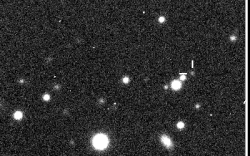Isonoe (moon)
Isonoe /aɪˈsɒnoʊ.iː/, also known as Jupiter XXVI, is a retrograde irregular satellite of Jupiter. It was discovered by a team of astronomers from the University of Hawaii led by Scott S. Sheppard in 2000, and given the temporary designation S/2000 J 6.[3][1]
 Isonoe imaged by the Canada-France-Hawaii Telescope in December 2001 | |
| Discovery[1] | |
|---|---|
| Discovered by | Scott S. Sheppard et al. |
| Discovery site | Mauna Kea Obs. |
| Discovery date | 23 November 2000 |
| Designations | |
Designation | Jupiter XXVI |
| Pronunciation | /aɪˈsɒnoʊ.iː/ |
Named after | Ισονόη Isonoē |
| S/2000 J 6 | |
| Adjectives | Isonoean /ˌaɪsənoʊˈiːən/ |
| Orbital characteristics [2] | |
| 23217000 km | |
| Eccentricity | 0.246 |
| −725.5 days | |
| Inclination | 165.2° |
| Satellite of | Jupiter |
| Group | Carme group |
| Physical characteristics | |
Mean diameter | 4 km |
| 22.5 | |
Isonoe is about 3.8 kilometres in diameter, and orbits Jupiter at an average distance of 23,833,000 Km in 751.647 days, at an inclination of 166° to the ecliptic (169° to Jupiter's equator), in a retrograde direction and with an eccentricity of 0.166.
It was named in October 2002 after Isonoe, one of the Danaïdes in Greek mythology, and a lover of Zeus (Jupiter).[4]
Isonoe belongs to the Carme group, made up of irregular retrograde moons orbiting Jupiter at a distance ranging between 23 and 24 Gm and at an inclination of about 165°.
References
- MPEC 2001-A28: S/2000 J 2, S/2000 J 3, S/2000 J 4, S/2000 J 5, S/2000 J 6 2001 January 5 (discovery and ephemeris)
- S.S. Sheppard (2019), Moons of Jupiter, Carnegie Science, on line
- IAUC 7555: Satellites of Jupiter Archived 2002-09-16 at the Wayback Machine 2001 January 5 (discovery)
- IAUC 7998: Satellites of Jupiter 2002 October 22 (naming the moon)